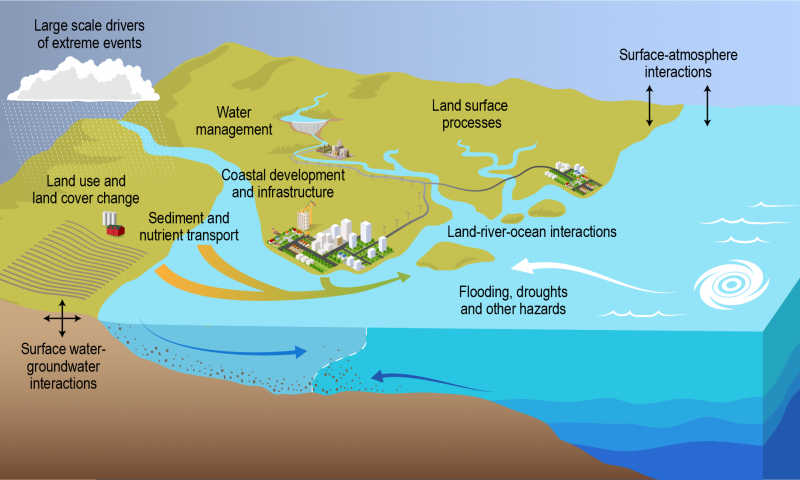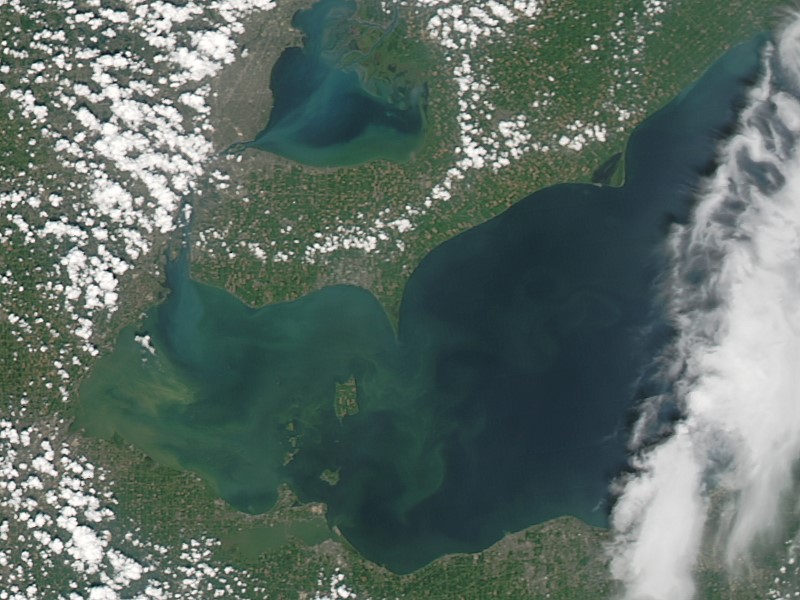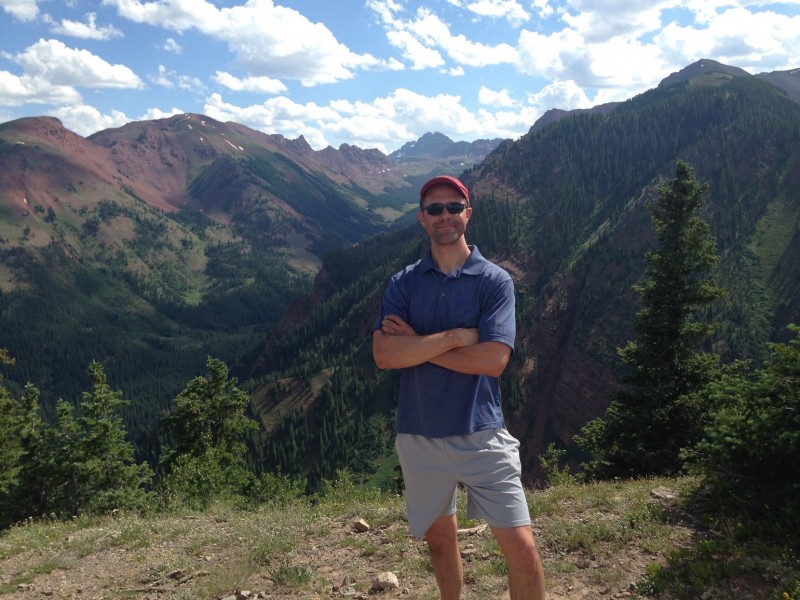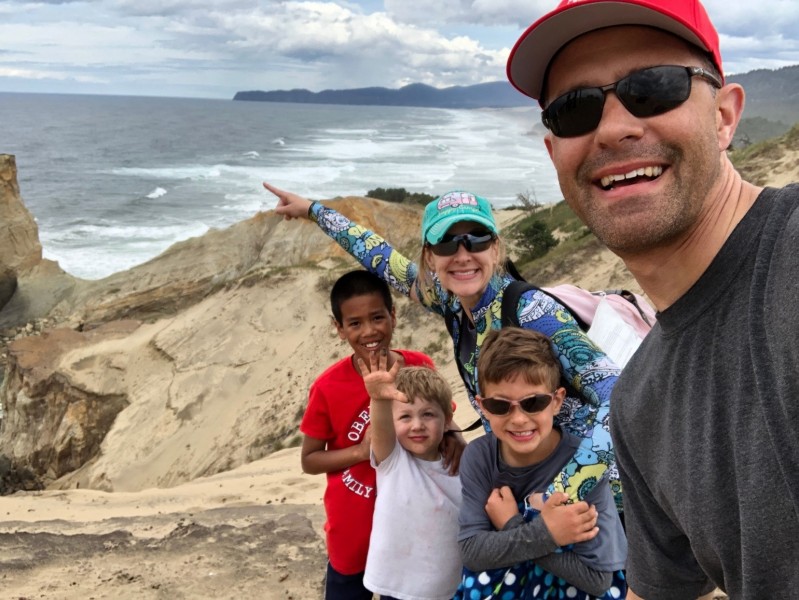Ian Kraucunas: Portrait of a Projects Leader
From atmospheric science to multisector dynamics to coastal systems, one scientist likes taking on new challenges
Ian Kraucunas, a scientist and manager at Pacific Northwest National Laboratory (PNNL), has led a series of projects focused on the complex interactions among human and natural systems. Now he’s bringing his diverse experience to two new coastal science projects sponsored by the U.S. Department of Energy (DOE).
Kraucunas is the lead principal investigator for Integrated Coastal Modeling (ICoM), which was launched in 2019. ICoM focuses on bringing multiple modeling tools together to study the complex interactions among coastal systems.
More recently, Kraucunas helped lead a team that successfully proposed another new project called Coastal Observations, Mechanisms, and Predictions Across Systems and Scales (COMPASS), which includes major DOE investments in both measuring and modeling key coastal processes.
“Looking ahead, these projects are building the foundation of DOE’s coastal capabilities,” says Kraucunas.
The need is real. About 50% of Americans live on or near a coastline, the geographical zone that ties land to oceans, lakes, and rivers. Coastlines are regions of great economic, social, and ecological vitality. However, their intersecting natural and societal resources remain vulnerable to unique risks.
Such risks vary from location to location and span a wide range of timescales. For example, hurricanes along the Atlantic and Gulf Coasts bring storm surges, extreme precipitation, and severe impacts on infrastructure. These same regions are experiencing long-term trends that exacerbate risks, including sea-level rise, increased concentrations of people along the coastline, and degraded ecosystems.
Understanding how different forces interact in narrow coastal bands “requires integrated approaches that leverage many different disciplines,” says Kraucunas.
At the same time, these approaches need to be useful over a span of timescales.
“We need tools that allow us to study the evolution of coastal regions over decades, but which we can also use to resolve extreme events that happen over just a few hours,” he says. “It’s a huge challenge.”
Complex Coastlines
In 2019, Congress asked DOE to begin studying coastal regions. Kraucunas was tasked with putting a team and a vision together for ICoM.
The initial ICoM target area is the northern portion of the Mid-Atlantic coastline. Roughly, that demarks a stretch of bays, beaches, and cityscapes from the New Jersey Shore to the mouth of the Chesapeake Bay.
Beyond that, of course, coastlines “are affected by rivers and their watersheds hundreds of miles inland,” says Kraucunas, as well as by ocean dynamics. “If you want to understand what is happening at the coast, you have to consider a much broader domain.”
Hence, the ICoM study region extends far north and west. It encompasses the Delaware and Susquehanna river basins, which are threaded together by rivers and tributaries, and watersheds in five different states. The region features a wealth of existing research to build on, including data and models from many different agencies and groups.
The rationale for choosing the Mid-Atlantic also pivots on the physical, ecological, and economic dynamism of the region.
“It has a wide range of environments,” Kraucunas says, “from major urban centers to areas that remain in a more natural state, all of which are exposed to many different stresses.”
Intellectual Breadth

However, this same complexity also means that many different disciplines are needed to develop, calibrate, and analyze models that simulate how the region’s different human and natural systems interact. Accordingly, the ICoM team includes researchers from a dozen different institutions, including four DOE national labs.
The needed intellectual breadth for ICoM is also supported by four different DOE program areas, including Earth System Model Development, Regional and Global Model Analysis, and MultiSector Dynamics, all of which fall under the Earth and Environmental System Modeling program. ICoM also receives funding from DOE’s Environmental System Science Program. All of these programs are part of DOE’s Office of Biological and Environmental Research (BER).
Any BER project or program is intended to create new knowledge and scientific understanding and to “inform models that can ultimately inform decisions,” says Kraucunas.
In the case of ICoM, he adds, the imperative is also to develop integrated tools that can be applied to other geographic contexts.
Meanwhile, having so many program managers and team members to interact with, says Kraucunas, is part of the challenge―and the fun.
COMPASS Directions
In early 2020, just as the COVID-19 pandemic was starting, Kraucunas and a number of colleagues were given an opportunity to develop another coastal project for DOE. Over the past year, they developed and successfully defended their proposal, which includes two pilot projects under the common banner of COMPASS.
COMPASS is complementary to ICoM in several ways. Like ICoM, it engages a wide range of disciplines and partner institutions, and it includes the development and application of new model components.
However, COMPASS also includes major new DOE investments in coastal observations and measurements. These include the expansion of existing research sites, the development of new sites, and a new sampling program called EXCHANGE, which is short for Exploration of Coastal Hydrobiogeochemistry Across a Network of Gradients and Experiments.
COMPASS also includes two study domains. One of these is the Chesapeake Bay, which is part of the ICoM study region. But there will also be substantial efforts in the Great Lakes, the world’s largest freshwater lake system. Both COMPASS domains will include a robust portfolio of new measurements, experiments, analyses, and fine-scale modeling aimed at better understanding ecological and biogeochemical processes at the terrestrial-aquatic interface.

The Great Lakes studies are exciting because they look at a much different coastal region that is, for part of the year, dominated by ice and snow cover, says Kraucunas. “It is also unique, and really cool, to compare and contrast a major freshwater system with the tidal, saltwater context of the Chesapeake Bay.”
COMPASS activities in the Great Lakes also include watershed-scale modeling of a specific river system in Western Lake Erie and regional-scale modeling of the interactions between the lakes, the surrounding land areas, and the atmosphere above. These modeling activities are carefully coordinated with the COMPASS measurements in Lake Erie, and all of the COMPASS activities are designed to leverage and complement existing research activities in both regions.
Like ICoM, COMPASS is also funded by multiple BER programs: the pilot study focused on “Field, Measurements, and Experiments” is sponsored by the Earth and Environmental System Science Program, while “Great Lakes Modeling” is funded by the Earth and Environmental System Modeling program.
Future Coastal Plans
The ambitious combination of tools and analyses planned in the ICoM and COMPASS projects is exciting, says Kraucunas, because DOE is really making a large investment in science gaps that have been identified by the coastal science community. “There are also many opportunities to collaborate with other DOE projects and with a wide range of other agencies and groups.”
COMPASS and ICoM are also developing capabilities that could be extended to other geographic regions. PNNL was recently asked to develop a scoping study for modeling activities in the Puget Sound. BER has also funded research in the Gulf of Mexico region, as well as coastal processes in the Arctic. Other DOE offices also fund coastal research and development, for example in offshore wind resources and marine energy technology.
“Each costal system is unique, but there are processes and interactions that are common among them,” says Kraucunas. “We want to develop capabilities that can be applied to multiple geographies.”
Academic Trajectory
Kraucunas has been interested in climate science ever since junior high, when he conducted a science fair experiment on the greenhouse effect. “I put dry ice in one glass jar and put it out in the sun next to an identical but empty jar,” he says.
Although he detected a small temperature difference between the jars, he now thinks his experimental design was flawed.
“There were too many uncontrolled variables, those containers were probably not airtight, and I used household thermometers,” he laments.
After finishing high school at Robinson Secondary School in Fairfax, Virginia, where he was a valedictorian and voted most likely to succeed, Kraucunas participated in a summer internship at the U.S. Naval Research Laboratory in Washington, D.C.
“I was shown how to conduct experiments with lasers to determine if Raman scattering could be used to detect contaminants in soils.” The work resulted in his first scientific paper and piqued his interest in physics, which he ultimately chose as his first major at the University of Virginia, or UVA (B.A. Physics, B.A. Environmental Sciences, 1997).
However, once he arrived at UVA, Kraucunas “took every kind of science you can imagine,” he says, including organic chemistry and evolutionary biology, along with the university’s famous liberal arts core. Then a third-year course in synoptic climatology set him on his life’s path.
“That sold me,” says Kraucunas, who was gripped by the science and ultimately completed a second major in environmental sciences, with a concentration in atmospheric science. “I was genuinely interested in climate change because it had so many implications for society.”
Other Scientific Topics Too

In the doctoral program at the University of Washington (Atmospheric Sciences M.S. 2001, PhD 2005), “I had the privilege of working with some of the brightest minds in climate science,” including main mentor and PhD advisor Dennis L. Hartmann, John M. “Mike” Wallace, and Robert A. Houze, Jr. who later held a joint appointment at PNNL.
“I also had an amazing cohort of graduate student colleagues,” says Kraucunas. “And I still interact with many of them today.”
But he also retained his passion for diving into other scientific topics. In addition to his formal academic degrees, he completed a Certificate in Environmental Management from the university’s Program on the Environment.
The certificate involved coursework in environmental economics, policy, and other topics. It also included a capstone project that required working with a multidisciplinary team and developing a business plan. The team coach was national and global security expert Gretchen Hund, who was at PNNL at the time.
“It was really cool and something really different,” said Kraucunas, “and I appreciate that my advisor gave me the flexibility to participate.”
Every Year a New Subject
By the end of his studies, Kraucunas knew he was not interested in a traditional academic job. “I wanted to do something that would allow me to work on a wider range of topics and inform decisions more directly,” he says.
Hartmann sent him a posting for a position as a program officer at the National Academies of Science, Engineering, and Medicine in Washington, D.C. It seemed ideal for a new PhD with a talent for synthesizing science and working with people.
Hired in 2005 and on staff through 2010, Kraucunas reveled in what he calls “an absolutely unbelievably fantastic job―I was lucky to stumble into that opportunity at that phase of my career.”
Early on, Kraucunas was study director in 2006 for one of the hottest National Research Council reports of the day, Surface Temperature Reconstructions for the Last 2,000 Years. It investigated the famous sudden upward curve in planetary temperatures, popularly called “the hockey stick.”
Paleoclimate was only one of the areas Kraucunas got to explore in a job that required getting up to speed on new topics based on requests from different government agencies.
“Every year,” he says, “I got to learn about a brand-new area of climate science.”
Kraucunas recruited experts from around the country to join study committees, organized workshops, edited major reports, and nearly every day rubbed shoulders with the brightest minds in climate science and related fields.
Another really satisfying aspect of the job, says Kraucunas, was knowing that the reports he worked on were being used by decision-makers. “We met regularly with representatives from the U.S. Global Change Research Program and its participating agencies. For some reports, such as America’s Climate Choices, we even got to brief members of Congress and their staffs.”
Back to the Northwest
Photo is courtesy of Kraucunas." data-entity-type="" data-entity-uuid="" src="https://climatemodeling.science.energy.gov/sites/default/files/u3349/IanK-5.jpg" />
In late 2010, Kraucunas was recruited to join PNNL by Charlette Geffen, who is now Director of Program Development for PNNL’s Earth and Biological Sciences Directorate (EBSD), and by the late Anthony “Tony” Janetos, an ecologist and science policy expert who was then Director of PNNL’s Joint Global Change Research Institute (JGCRI) at the University of Maryland.
PNNL “was a major career change,” Kraucunas says, “a total learning curve” that took him from someone who had learned to “drive projects from the back seat” to a manager of people and programs.
Kraucunas served as deputy director (2011―2015) for PNNL’s Atmospheric Sciences and Global Change (ASGC) Division, and as a technical group manager for Earth System Analysis and Modeling, a line manager role for about 25 staff.
In 2015, he become ASGC division director. During his tenure, the division grew by 40% and now has about 200 staff, with expertise ranging from atmospheric physics to economics to ecosystem science.
“One of the great things about PNNL,” says Kraucunas, “is the amazing array of talent and the strong incentives to bring diverse teams together.”
Last year, Kraucunas shifted into a new role as Chief Science and Technology Office (CSTO) for EBSD, a role that focuses heavily on strategy and capability development.
It’s a great match, says Malin M. Young, Associate Laboratory Director for EBSD. "Ian’s passion for interdisciplinary science, his technical expertise in earth systems science, and his experience leading diverse research teams make him a great fit for the CSTO position.”
Exploring Interactions
At PNNL, Kraucunas also had the opportunity to lead several research efforts that ultimately paved the way to ICoM and COMPASS.
From 2012 to 2014, he was initiative lead for the Platform for Regional Integrated Modeling & Analysis (PRIMA), an internal lab investment that focused on developing new modeling tools for studying interactions across different human and natural systems.
“PRIMA was really groundbreaking,” he says. “We identified some big science gaps and started building tools to fill them.”
From 2013 to 2015, he was principal investigator for a related DOE-funded effort called Regional Integrated Assessment modeling (RIAM), a collaboration with Oak Ridge National Laboratory in Tennessee that focused on human-earth system interactions in the Gulf Coast region of the United States.
“These projects were really rewarding,” Kraucunas noted, “because we were actually doing the interdisciplinary, integrated science that all of the National Academy reports that I had worked on were calling for.”
Then, from 2016 to 2018, he led a large, multi-institutional team that launched a new DOE Scientific Focus Area called Integrated Multisector Multiscale Modeling (IM3). IM3 leveraged the tools originally developed in PRIMA and RIAM while embracing a much more ambitious agenda.
“We wanted to study the evolution of important systems, such as water and energy, that are tightly linked with each other and with other human and natural systems over a wide range of timescales,” says Kraucunas. IM3 was also an opportunity to bring in an even more diverse range of disciplines, including academic partners who brought key capabilities to the project.
PRIMA, RIAM, and IM3 were also part of the foundation for DOE’s new coastal projects. Coastal regions are hotspots for many climate impacts, and they are incredibly complex.
“Understanding coastal processes and building models that can predict how they may change over time requires accounting for a huge range of factors and influences,” says Kraucunas. “It is inherently interdisciplinary.”
He also finds it satisfying to see many of the tools and team members from PRIMA, RIAM, and IM3 “now being deployed and further developed as part of our coastal activities, as well as in other projects.”
A Family on the Move

When Kraucunas arrived at PNNL, it was a homecoming of sorts. He and his wife, Katie Oberhofer, a speech pathologist, met in Seattle and have explored many corners of the Pacific Northwest together.
The region also resonated with his happy days in graduate school, where among other things he traveled as part of the university’s Ultimate Frisbee club.
The Tri-Cities area of Washington State, where the main campus of PNNL is located, turned out to be a great place for the couple to start a family. (They now have three sons, ages 6, 9, and 11.) The Pacific Northwest also fits their outdoor lifestyle, with lots of hiking and biking opportunities.
But Kraucunas and Oberhofer have always been on the move. He was born in Australia, to American ex-pats, before moving to Connecticut as a toddler and then to Virginia. She was born in Seattle but spent several years in Brussels, Belgium, and in the Atlanta area. The couple has traveled together extensively across the United States as well as to Mexico, Bermuda, Uganda, many European countries, and Thailand, which is where they adopted their oldest son.
In 2020 and part of 2021, with home offices required and the children out of school, the Kraucunas-Oberhofer family sequestered at a small house in Lincoln City, Oregon, nestled in between the beach and a forested area.
“We love the Oregon coast, and our kids have really enjoyed exploring our new environment.” Their younger two sons even started a “clean forest club” that caught the attention of the local parks department and ultimately landed them on television in Portland.
Soon, the family will relocate again, this time back to Seattle, where Kraucunas will work out of PNNL’s Seattle Research Center. But they plan to continue returning to the Oregon Coast regularly and to resume international travel once the pandemic ends.
Meanwhile, “coastal science,” says Kraucunas, “is definitely something I am embracing.”

